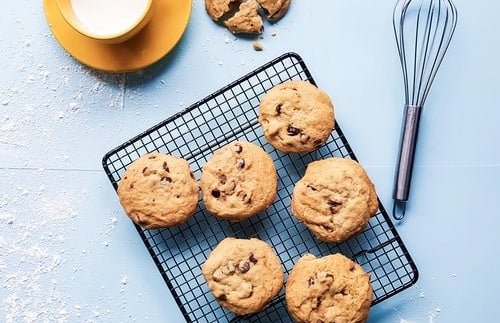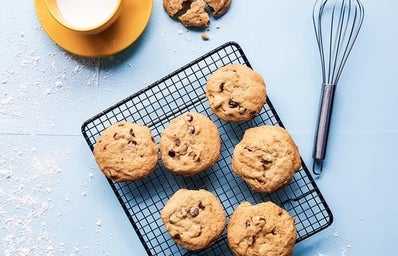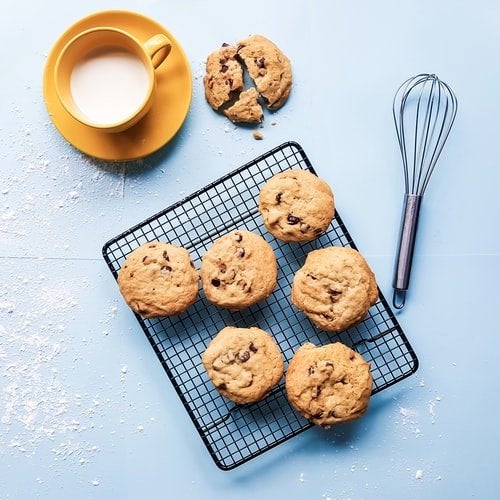I’ve discovered that one of the quickest ways to make friends is by sharing food, particularly something sweet like cookies. While my social skills may not always be top-tier, I find that my baking skills can help bridge any gaps and bring people together. Plus, cookies are simple to make, requiring just a few basic ingredients and standard kitchen equipment.
To make cookies, there are a few core ingredients needed.
- Sugar
All cookies require some form of sugar; cookies without sugar are typically referred to as crackers. The primary types of granulated sugar used in baking include light brown sugar, white sugar, and dark brown sugar. The main distinction among these sugars lies in their molasses content.
Brown sugar is essentially white sugar with molasses added to it. The only variance between dark and light brown sugar is the concentration of molasses.
In my chocolate chip cookie recipe, I prefer using a combination of white sugar and brown sugar. This combination lends a nuttier flavor and a chewier texture to the cookies.
However, it’s important to note that brown sugar can harden over time, forming clumps. To prevent this, store it in an airtight container. If your brown sugar does harden, you can soften it by placing it in hot water.
Confectioner’s sugar, also known as powdered sugar, is less commonly used in cookies but is essential for most icings. It’s important to sift the confectioner’s sugar to remove any clumps. Light, cake-like cookies may use confectioner’s sugar instead of granulated sugar for a softer texture.
- Butter (Fat)
I prefer using unsalted butter in my baking. However, if salted butter is used, it’s important to note that it inherently contains approximately ¼ teaspoon of added salt per stick.
One of my favorite baking techniques is browning the butter. This process enhances the flavor profile of the butter, lending a rich, nutty taste to the baked goods.
*Some recipes call for oil as the fat. This will typically result in a denser, flater cookie because the oil is 100% fat. For oil, you can spray your measuring cup with nonstick cooking spray and it will come right off. This tip works for anything sticky, like honey
- Salt
I always include salt in my cookie recipes to balance out the sweetness. It’s essential to use kosher salt rather than table salt. Kosher salt has a milder flavor compared to table salt and reacts differently chemically. When baking recipes specify salt, they typically mean kosher salt.
- Flour
Flour is a fundamental ingredient in cookies, and my go-to choice is unbleached all-purpose flour. However, depending on the recipe, I’ve also experimented with other types of flour. For instance, I’ve incorporated oats into my oatmeal cookies for added texture, and almond flour for specialty cookies like marzipan almond cookies and macarons.
- Extract
I incorporate additional flavorings such as vanilla extract, almond extract, or maple extract into my cookie batter by adding them to the whisked butter and sugar mixture. This method ensures that the fat in the butter evenly disperses the flavor of the extract throughout the batter. Therefore, as I whisk the butter and sugar together, I also incorporate the chosen extract to ensure a uniform distribution of flavor in the final cookies.
- Eggs
I use standard large eggs. Most recipes will call for eggs at room temperature. This ensures a smoother incorporation into the batter, better aeration, and even baking, all of which help the texture and consistency of the finished product. To get your eggs to room temperature, you can submerge them in warm water for a few minutes.
- Milk
For cookies that require dairy, such as a small amount of milk, I opt for full-fat whole milk. I prefer using cow’s milk over non-dairy alternatives because it lends a richer flavor to the dessert.
Ensure that ingredients requiring refrigeration are brought to room temperature before using them in your recipe. If you need to quickly warm cold items like milk, you can microwave them for a few seconds to achieve the desired temperature.
- Baking soda/baking powder
Both powders are essential ingredients in cookies, responsible for their rising. Baking soda reacts with acidic ingredients to produce carbon dioxide. On the other hand, baking powder generates gas when mixed with liquid. Together, they create light and fluffy cookies.
Cookies often require baking soda rather than baking powder due to its numerous benefits. Baking soda initiates the Maillard reaction, contributing to the browning of food. In cookies, this reaction results in beautifully golden edges. Additionally, baking soda, also known as sodium bicarbonate, adds sodium to the recipe, which enhances flavor. This dual role of browning and flavor enhancement makes baking soda a preferred leavening agent for cookies.
Lastly, there will be some basic equipment needed for whenever you bake cookies:
- Baking sheets/pan
The standard baking sheet is 18” x 26”.
- Parchment paper
Parchment paper can be reused multiple times. I prefer parchment because it automatically prevents sticking. However, you can use foil and spray or a baking silicon mat.
- Oven
It’s important to verify the accuracy of your oven temperature, especially with older models, as they can often be unreliable. An oven thermometer works for this task.
- Measuring cups and spoons
Unlike cooking, where improvisation with measurements is feasible, baking requires more precision. This is because baking involves intricate chemical reactions, where even the slightest variation in ingredient amounts can disrupt the balance and compromise the final product. To ensure this, I suggest stainless steel measuring cups because they are very sturdy.
- Mixer or whisk
If you bake frequently, consider investing in a hand mixer for its affordability and efficiency, especially because many recipes require whipping. Stand mixers are ideal for intense and frequent baking routines, as they handle most tasks, but for most home bakers, a hand mixer suffices.
- Spatula
Perfect for getting every last scrap, and no waste!
- Cookie scooper
While not essential, a cookie scooper can make the task easier, faster, and less messy. You can also use a tablespoon or an ice cream scooper with a release mechanism.
- 2 large bowls
You will need two bowls to mix your ingredients: one for the dry ingredients and one for the wet ingredients.
Happy baking!
Written by: Madison Butchko



